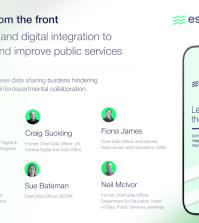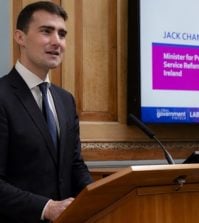The power of peril: how to get government legacy transformation underway

Elected leaders’ eyes may glaze over when technologists talk about digital transformation – but the threat of cyber attacks catches their attention, national IT leaders explained at the Global Government Digital Summit. Matt Ross hears the group debate how best to clean up their poisoned IT legacies
Too often, digital service reform projects just put “lipstick on a pig”, said Kevin Cunnington: “We digitise the front end, but the legacy remains intact. Most of what we’ve done is digitise, not digitally transform.” So a paper form might be replaced with an online form, for example, but behind the scenes the administrative process is as inefficient and labour-intensive as ever.
Cunnington, a former director general of the UK’s Government Digital Service (GDS), was speaking in the session on ‘Escaping the legacy trap’ at the Global Government Digital Summit: an annual gathering of digital leaders from around the world, attended in 2022 by 30 people from 12 countries. Rebuilding business processes is much more difficult than polishing the user interface, he acknowledged, but it is the only way to realise the full potential of digital technologies – radically cutting transaction times and costs, automating data exchanges, improving decision-making, and making IT systems more economical and adaptable.
The benefits of digital transformation are well understood by technology professionals, but few elected leaders fully appreciate them – so securing the capital funding to transform business processes is a challenge in many countries. As a result, many services remain dependent on ageing, unstable legacy systems, with high running costs and the constant risk of breakdown. There are, however, some arguments that have real traction with politicians.
The power of peril
In the US, said federal chief information officer Clare Martorana, digital leaders have demonstrated the cyber risks “in order to get to the legacy transformation that we need to make”. Politicians recognise the threat from hostile nations and online criminals, she explained, and understand that ageing IT systems are vulnerable to attack. What’s more, “we have an extraordinary amount of data about the threat environment, where we might not have that fidelity on some of the other object classes that cause expense in IT budgets”.
It’s a similar story in the UK, said deputy national statistician Alison Pritchard. When she ran GDS, after Cunnington’s stint in the job, “the most telling moment came when a colleague said: ‘The risk on security is increasing month by month, but we’re acting as if it isn’t changing’.” In her view, “it was undoubtedly the security risks that started the debate in the UK,” she said. “We then layered on operational resilience, commercial challenges.” Securing funds to rebuild business processes, government ultimately realised efficiencies and service improvements: “It was the transformational opportunity that provided the return on investment.”

Operational resilience also has traction with politicians and departmental heads, commented Megan Lee Devlin, chief executive of the UK’s Central Digital and Data Office – particularly when they’ve experienced a service outage or data loss. “Quite a significant proportion of our spending review [funding allocation] was attributed to addressing our legacy risk, both for security and operational resilience reasons,” she said. “We’re using a common framework to assess legacy risk across government in order to direct that funding towards the highest risk systems.”
From administration to transformation
To address these security and resilience risks and realise the potential of digital, governments will have to rethink their approach to IT spending and capital investment – treating transformation as a strategic priority. “A lot of IT organisations live in what’s called departmental administration,” commented one departmental leader. “You’re lumped in with finance and public affairs and legal, and there’s a pot of money – and what you get in IT is taken away from those other groups, whereas if you’re in a mission space there’s much more money available.”
Governments also need to find ways of considering the operational delivery benefits of digital transformations when calculating returns on investment, rather than simply counting the savings within IT administration. “As with any business, the digital, data and technology teams don’t see the bottom line change; it’s our operational colleagues who see those benefits,” said Lee Devlin.
What’s more, because many reform programmes involve a shift from on-premises hardware to cloud services, the proportion of revenue spending required is rising relative to capital: Lee Devlin’s team works closely alongside the Treasury “around where we can capitalise our cloud spend more. We certainly have the right appetite within Treasury to move to more modern approaches”.
Outside in, or inside out?
With the funds secured, IT leaders can move onto project design – and here, the assembled leaders debated how best to integrate transformation teams into the department’s operations. “This is an important decision for IT departments,” said Dr Melvin Greer, chief data scientist for the Americas at event knowledge partner Intel. “Do I create a separate organisation of people with technical knowledge? Or do I take those people and embed them inside the domain organisations, the primary users of the legacy system?”
Creating a central team of technical specialists means they’ll be “learning from each other; they have a standard way of creating and reusing technical approaches; they can establish common methods and tools; and they can share successes and failures,” Greer commented. “If we, on the other hand, embed technologists inside domain organisations, then not only do technologists benefit by learning how to do the technology consistently, but they also learn the domain piece as well”. In his view, this latter approach has generally resulted in a better match with the organisation’s needs.

Embedded technologists must, however, retain a certain distance from the departmental IT teams hosting them – remaining insulated from the daily demands of crisis response: “If you want anything to get done, you do need a set of people focused on development who don’t have operational responsibilities,” said one digital leader. “And they can’t have responsibilities to fix the legacy system; they need to be absolutely focused on developing new technology.”
It is also important to “ruthlessly manage scope,” they added. “So many projects have been killed by scope-creep, collapsing under their own weight. That may require a gatekeeper, who might be an executive sponsor multiple levels above who can say: ‘That’s not in scope right now; we’ll put it in the backlog and do it later’.”
As digital transformation projects get underway, Greer said, digital leaders do well to prioritise understanding and marshalling the raw material of digital services: data. “Leaders absolutely do well to capture who’s got what data; who’s got access to it; where it’s flowing; its formats and classification,” he said. “And there’s a side benefit: as soon as these leaders find out how the data works, they develop a deeper understanding of the organisation. They can use that knowledge to help communicate the impact of a data-centric approach and how best to modernise both the infrastructure and the applications.”
Heads in the cloud
These days, those modernisations often involve a shift to the cloud. This demands a really robust pre-cloud migration strategy, said Greer: if organisations lack an understanding of their existing infrastructure or don’t prepare carefully for the migration, then “moving to the cloud can be excruciating”. It’s important to consider whether to go with a single cloud provider or adopt a “hybrid multi-cloud” strategy, using “multiple clouds that are aligned based on function”. This approach can often produce better results, he argued, but demands expertise and careful planning.
Given a successful cloud service implementation, the focus can shift to “measurement and marketing”, said Greer – using evidence and testimonials to demonstrate the project’s value.
Having surmounted all these challenges, commented one participating civil servant, digital project leaders face one more hurdle. “The problem for us is switching off our old systems,” they said. When a significant proportion of service users remain wedded to the previous service, there’s a risk that “we end up in this purgatory where we run dual systems – and that’s the biggest challenge we have right now”.
Technology is a people issue
These comments on marketing and public adoption illustrated an essential truth within the world of digital services: success is not determined by the quality of the coding or infrastructure, but by a system’s ability to win people over and encourage them to change their behaviour. “Building capability is always about people,” said one departmental IT chief: very human factors will decide both how a project is developed, and whether it becomes popular. From the perspective of a departmental CIO, they added, “the biggest problem we often have is that people don’t feel empowered to take the initiative. And that’s one of the keys to getting out of the legacy trap: empowering people to solve the problems”.

As chief information officer of Canada – the Government of Canada hosted the Summit – Catherine Luelo concluded the event. She too noted that effective digital transformation “isn’t so much about the technology as it is about the people; about the culture; about changing how work gets done”. And given these human factors, she said, it had been wonderful to once again gather in a room with her peers from around the world “to exchange ideas and continue to build the community that we’ve taken online the last two-plus years”.
Digital technologies proved invaluable during the pandemic, keeping public servants connected and making it possible to maintain services to the public through the tightest lockdowns. But even for a group of the world’s most senior public sector digital professionals, nothing quite matches the personal connections and free-flowing conversations to be found when people meet face to face.
For more ways to address legacy challenges, see the ‘Improving capital investment’ chapter of our new report: ‘The digital leader’s toolkit: 21 ways to transform government’.
The 2022 Global Government Digital Summit was hosted by the Government of Canada in Ottawa in October. The first article covered the event’s evening session, including the responses to one digital leader’s plea for assistance; the second examined the discussions on developing digital ID systems; the third covered digital leaders’ views on how to drive digital transformation; and the fourth issues around leadership and workforce.
Although the Summit is a private event, GGF produces these reports to share as much of the discussions as possible with our readers – checking before publication that participants are happy to be quoted.
Visit https://digital.globalgovernmentforum.com/ to learn more about the Summit.























